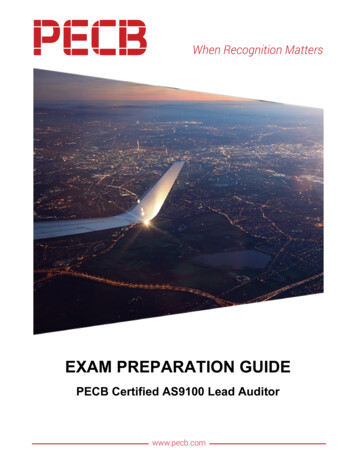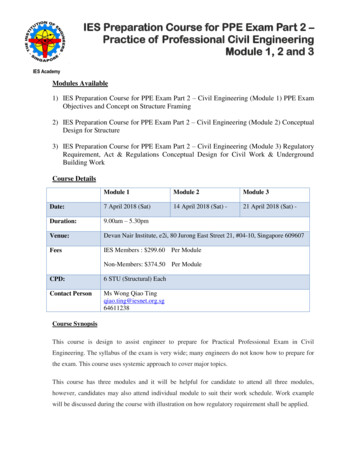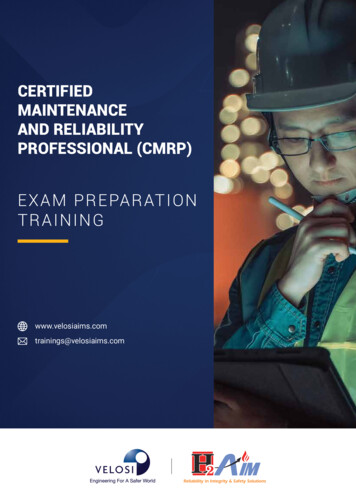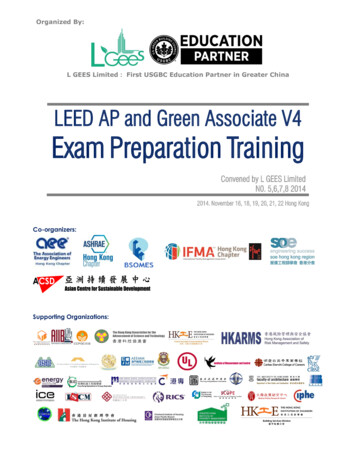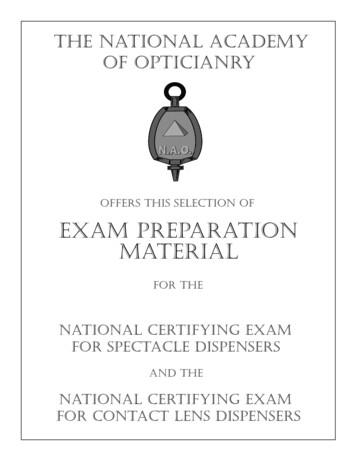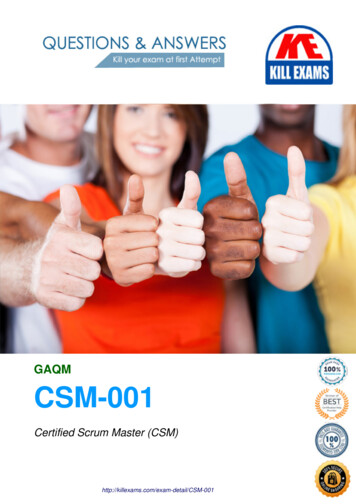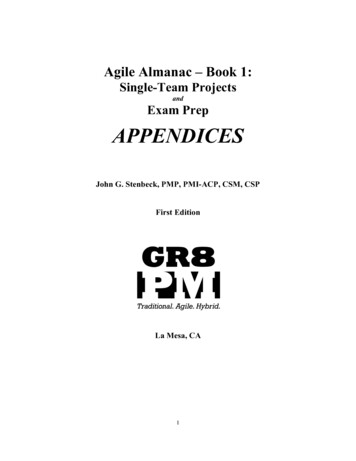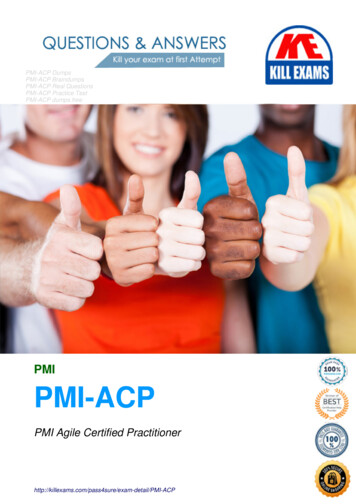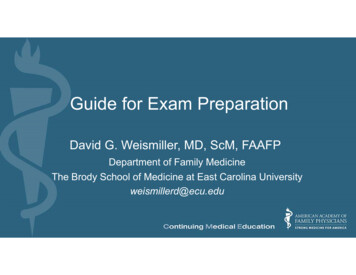
Transcription
Guide for Exam PreparationDavid G. Weismiller, MD, ScM, FAAFPDepartment of Family MedicineThe Brody School of Medicine at East Carolina Universityweismillerd@ecu.edu
Learning Objectives1. Manage anxiety in the anticipation of an importantexamination.2. Develop an individual plan of study for thecertification/recertification examination in FamilyMedicine.3. Demonstrate specific test-taking techniques.4. Explain the examination process forcertification/recertification in Family Medicine.
THE EXAM
AAFP & ABFMAmerican Board of Family Medicine, Inc.1648 McGrathiana ParkwayLexington, Kentucky 40505-4294Phone: 859-269-5626 or 888-995-5700Support Center: 877-233-7437
ndinfobooks.aspx
Recertification ExaminationABFM– Exam Format All multiple choice – 4 answer– Stem and options (A, B, C, D) Five Sections Three general portions– Section 1 – 120 Multiple Choice Questions (120 minutes)– Section 4 – 80 multiple choice questions (95 minutes)– Section 5 – 80 multiple choice questions (95 minutes) Two module choices– Selected on exam day during the exam– 45 questions each (45 minutes/module)
Understanding the ExamYou Will Be Taking
(Re)Certification Examination ABFM– Exam Format All multiple choice – 4 or 5 answers– Stem and options (A, B, C, D) Two general portions Two module choices– Selected on exam day during the exam– Exam tutorial www.theabfm.org Preview of the look and feel of a computerizedexamination
Exam Tutorial Go to https://www.theabfm.org/moc/examtutorials.aspx Click ABFM Exam Tutorial, click Start, and the tutorialwill begin.HomeworkAssignment#2
Exam Preparation Guidance 6 videos from the ABFM’s psychometrician https://www.theabfm.org/moc/exampreparation.aspx
Computerized Testing Testing is proctored by Prometric landing.aspx
Scoring No penalty for incorrect answers Leave no question unanswered Guess if you don’t know Setting a passing score– Angoff Method – using a group of peers to estimatethe percentage of family physicians who wouldanswer each question correctly
Passing Threshold – Angoff Technique
Pass Rates(Combined %390201382%81%390201485%90%380
Manage Your StressPreparing Yourself Prior to theExamination
SummarySteps to Creating an Effective Study PlanStepAction1Know what material is going to be on the exam in what proportions2Identify your level of need for study How you performed on last standardized ABFM exam Whether you practice broad-based family medicine3Identify how many hours you will need, would like, or will be able to study (Consider a minimum3-month lead time – if seeking serious score improvement [ 100 points, or if you are retaking theexamination])4Evaluate how the designated amount of study will fit into your weekly schedule5Identify and obtain the materials you plan to use6Focus on relevant material with which you are least comfortable and familiar7Divide up the material into your schedule as specifically as is reasonableAdapted from The ABFM.org
1. ABFM (Re)Certification Examination Content onspecificPsychogenicReprod – FemaleReprod – MaleRespiratory9%6%5%2%5%9%2%2%7%5%3%1%10% Special Sensory2% Population-based Care 3% Epidemiology, EBM, prevention, healthpolicy & legal issues, bioterror, qualityimprovement, geographic/urban/ruralissues Patient-based Systems 3% Clinical decision-making,communication and doctor-patientinteraction, family & cultural issues,ethics, palliative care, end-of-life care Module 1*13% Module 2*13%1. Know what material is going to be on the exam
Exam Modules*(Description: Page 15 of CIB) Ambulatory Family MedicineChild and Adolescent CareGeriatricsWomen’s HealthMaternity CareEmergent/Urgent CareHospital MedicineSports Medicine
2. Identify your level of need for study Broad population of practice– Studying is most likely to be effective (memorable) if you keepspecific clinical practice cases in mind while studying material thatapplies to those cases– Referring back to an article or study resource after seeing acomplex patient aids retention Narrowly defined population of practice– Systematic approach to reviewing the spectrum– Medical knowledge fades without periodic re-exposure– Include those areas not included in practice any longer, as well ascommon entities seen every day
3. Identify how many hours you willneed, would like, or will be able to study Be realistic Talk with coworkers, friends, and family
4. Evaluate how the designated amountof study will fit into your weeklyschedule Schedule your study time – on your calendar Daily time Key ingredient in exam success is scheduling regulartime to study Minimize long periods of study just onweekendsHomeworkAssignment#3
5. Identify and obtain the materialsneeded Nearly any high-quality, comprehensive studymaterial can be used effectively
“Your” Study Materials Board Review Express syllabus USPSTF A-Z– opics.htm ABFM Self-Assessment Modules AFP by Topic– http://www.aafp.org/afp/topicModules/viewAll.htm
Short-Term Study Tips Gaining points involves studying medical information –and there is a strong dose-response relationship Use the in-training exams as a pre- and posttest bfm.org/residency/ite.aspx
Pre- and Posttest Mark your starting point prior to studying and then tosee if your study schedule is effective Try to take it according to the standardized timing andinstructions Promotes focus on study– Allows one to actually SEE improvement
Using the in-training exams for pre- andposttests – an example.DateMonday following course(Pretest)One week later(Posttest 1)One week later(Posttest 2)Exam Questions201 In-training examinationQuestions 1-30201 In-training examinationQuestions 31-60201 In-training examinationQuestions 61-90 Goal is a minimum of 70% correct?Time30 minutes30 minutes30 minutes
6. Focus on the relevant material withwhich you are least comfortable andfamiliar Focus on established medicine Answer the question using THE MOST CURRENTinformation 9-month development cycle for the examinations, sobrand new information, no matter how reliable, isunlikely to appear as an item
7. Divide up the study material into yourschedule, as specifically as is reasonable Lectures(?)/Number of days until exam number oflectures reviewed each day– Schedule regular time to study– Start with those content areas that you find more challenging– Serious score improvement needs 10-14 hours of study time perweek (100 points)– Keep a “fact sheet” for last-minute review– Doing a lot of review questions is secondary(30 points) www.aafp.org/boardreview/questions https://www.theabfm.org
Using the In-training Exams for Pre- andPosttests and “Additional Questions”DateMonday following course(Pretest)Tuesday following course(Studied for 50 minutes; 10minutes “remain.”) Time for5 questionsFriday following course(Studied for 40 minutes; 20minutes “remain.”) Time for10 questionsOne week later (Monday)(First posttest)Exam Questions201 In-training examinationQuestions 1-30201 In-training examinationQuestions 31-36Time30 minutes5 minutes for questions then5 minutes to reviewannotated answers201 In-training examination 10 minutes for questionsQuestions 37-47then 10 minutes to reviewannotated answers201 In-training examination 30 minutesQuestions 48-78
Proceed with Studying, Taking WeeklyInventory of Progress Reevaluate at end of first week. If schedule is not asaccommodating as you anticipated, consider changesto your schedule OR the ambitiousness of your studyplan Consider using In-Training Exam items beforebeginning and after a month to see if performanceseems to be improving
How can we improve our response strategy intranslating our knowledge into the exam’sresponse format?Test-Taking Strategies
ABFM Tips for Test-Taking Read the stem carefully Read every response option (cross out the wrongones) Consider the tables and images carefully Answer only after considering all options If you do not know – guess! Go with the first thoughtful answer, unless you realizethat you actually made a mistake
ABFM Tips for Test-Taking Attempt to determine whether general knowledge orpatient-specific knowledge is being assessed. DO NOT try to out-guess the item number. Don’t read the answers first and try to find it in thequestions. Knowledge is TOO vast. Carefully manage exam time. ALWAYS answer all items before exiting exam.
TIP Both questions and answers have catch words; lookcarefully for them–––––––“except”“least likely”“most likely”“all but”“never”“always”“all”
“Catch Words”Six-year-old Hillary DeLong is brought to the emergencyroom by her mother. Half an hour ago she was bitten onher right arm by a neighbor’s dog. The recommendedfirst step in emergency treatment is to:A.B.C.D.Thoroughly cleanse the area with soap and waterReport the accident to the policeEncourage free bleedingCauterize the wound and suture it
TIP Avoid unfamiliar choices These are made up by good test writers
“Unfamiliar Choices”A pregnant woman at term with a 4-cm dilated cervix isfound to have marginal placenta previa with mildbleeding. The appropriate management is:A. Cesarean sectionB. Rupture of the membraneC. Internal podalic versionD. Use of Willett’s scalp traction forceps
TIP Analyze similar answers carefullyIf one merely restates the other, both are wrongIf one is the opposite of the other, one is correctIf answers look similar, but have different numbers,one is correct
“Similar Answers”The most appropriate treatment for erythrocytosisassociated with polycythemia vera and a hemoglobin of18.5 g/dL is:A. ChlorambucilB. Phlebotomy to maintain hemoglobin at 14 g/dL in men and12 g/dL in womenC. Phlebotomy to maintain hemoglobin at 16 g/dL in men and14 g/dL in womenD. Radioactive phosphorus (³²P)
“Similar Answers”The most appropriate treatment for erythrocytosisassociated with polycythemia vera and a hemoglobin of18.5 g/dL is:A. ChlorambucilB. Phlebotomy to maintain hemoglobin at 14 g/dL in men and12 g/dL in womenC. Phlebotomy to maintain hemoglobin at 16 g/dL in men and14 g/dL in womenD. Radioactive phosphorus (³²P)“If answers look similar, but have different numbers, one is correct”
“Similar Answers”A 55-year-old woman has had pain and swelling of her left calf for 4 days whiledriving across the country. Physical examination shows slight swelling andtenderness of the left calf, but no other signs of deep venous thrombosis. Shereports anaphylaxis after a previous injection of dye for intravenouspyelography. To promptly confirm the suspected deep venous thrombosis ofthe calf vein, you would now order:A.B.C.D.Impedance plethysmographyDoppler ultrasoundRadionuclide venography using 99m Tc macroaggregated albuminRadionuclide venography using 99m Tc-labeled erythrocytes
“Similar Answers”A 55-year-old woman has had pain and swelling of her left calf for 4 days whiledriving across the country. Physical examination shows slight swelling andtenderness of the left calf, but no other signs of deep venous thrombosis. Shereports anaphylaxis after a previous injection of dye for intravenouspyelography. To promptly confirm the suspected deep venous thrombosis ofthe calf vein, you would now order:A.B.C.D.Impedance plethysmographyDoppler ultrasoundRadionuclide venography using 99m Tc macroaggregated albuminRadionuclide venography using 99m Tc-labeled erythrocytes“If one merely restates the other, both are wrong”
TIP For answers with numbers or percentages– Pick mid-range levels– Pick values that look like the others
“Numbers or Percentages”Implantation of the fertilized ovum usuallyoccurs:A.B.C.D.2 to 3 days following ovulation6 to 7 days following ovulation10 to 12 days following ovulationExactly 14 days following ovulation
“Numbers or Percentages”Implantation of the fertilized ovum usuallyoccurs:A.B.C.D.2 to 3 days following ovulation6 to 7 days following ovulation10 to 12 days following ovulationExactly 14 days following ovulation
“Numbers or Percentages”At the end of 28 weeks of gestation(7 lunar months), the fetus weighs (in grams):A.B.C.D.1560010001800
“Numbers or Percentages”At the end of 28 weeks of gestation(7 lunar months), the fetus weighs (in grams):A.B.C.D.1560010001800
TIP Choose answers that are consistent with good familymedicine values
“Values”Three times in the past month, a 32-year-old woman has arrivedunexpectedly for consultation after hours at her family physician’soffice. She has also complained about the arrogance of thereceptionist. The next time she arrives to see the doctor when he isworking alone in the evening, he should:A. Tell her family that there is nothing wrong with her and that she should seea psychiatristB. Point out that she needs careful, thorough evaluation and give her the nextavailable appointment during scheduled office hoursC. Ask her to call the office the next morningD. Drive her out of the office
“Values”Three times in the past month, a 32-year-old woman has arrivedunexpectedly for consultation after hours at her family physician’soffice. She has also complained about the arrogance of thereceptionist. The next time she arrives to see the doctor when he isworking alone in the evening, he should:A. Tell her family that there is nothing wrong with her and that she should seea psychiatristB. Point out that she needs careful, thorough evaluation and give her the nextavailable appointment during sche
AAFP & ABFM American Board of Family Medicine, Inc. 1648 McGrathiana Parkway Lexington, Kentucky 40505-4294 Phone: 859-269-5626 or 888-995-5700 Support Center: 877-233-7437

